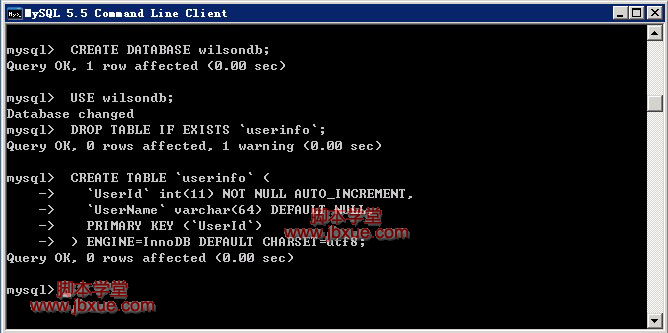windows 2003 环境下mysql数据同步(双主热备)配置指南,很经典的一篇文章,有需要的朋友可以参考下。
应用环境
OS: Windows Server 2003
1.数据库服务器242
IP:192.168.206.242
2.数据库服务器243
IP:192.168.206.243
MySQL版本
版本号:5.5.2
查询语句:SELECT VERSION();

数据库同步方式
两台服务器互为主从,双向同步数据

创建数据库表
为试验双向同步,简单编写了一个创建数据库和一个用户表的语句。
并分别在服务器242和243上的MySQL中执行语句。
CREATE DATABASE wilsondb;
USE wilsondb;
DROP TABLE IF EXISTS `userinfo`;
CREATE TABLE `userinfo` (
`UserId` int(11) NOT NULL AUTO_INCREMENT,
`UserName` varchar(64) DEFAULT NULL,
PRIMARY KEY (`UserId`)
) ENGINE=innodb DEFAULT CHARSET=utf8;

配置数据库my.ini文件
在242和243服务器MySQL的安装目录下找到my.ini文件
1.my.ini文件各配置项简单释义
my.ini详情及简单释义
# MySQL Server Instance Configuration File
# ----------------------------------------------------------------------
# Generated by the MySQL Server Instance Configuration Wizard
#
#
# Installation Instructions
# ----------------------------------------------------------------------
#
# On linux you can copy this file to /etc/my.cnf to set global options,
# mysql-data-dir/my.cnf to set server-specific options
# (@localstatedir@ for this installation) or to
# ~/.my.cnf to set user-specific options.
#
# On Windows you should keep this file in the installation directory
# of your server (e.g. C:Program FilesMySQLMySQL Server X.Y). To
# make sure the server reads the config file use the startup option
# "--defaults-file".
#
# To run run the server from the command line, execute this in a
# command line shell, e.g.
# mysqld --defaults-file="C:Program FilesMySQLMySQL Server X.Ymy.ini"
#
# To install the server as a Windows service manually, execute this in a
# command line shell, e.g.
# mysqld --install MySQLXY --defaults-file="C:Program FilesMySQLMySQL Server X.Ymy.ini"
#
# And then execute this in a command line shell to start the server, e.g.
# net start MySQLXY
#
#
# Guildlines for editing this file
# ----------------------------------------------------------------------
#
# In this file, you can use all long options that the program supports.
# If you want to know the options a program supports, start the program
# with the "--help" option.
#
# More detailed information about the individual options can also be
# found in the manual.
#
#
# CLIENT SECTION
# ----------------------------------------------------------------------
#
# The following options will be read by MySQL client applications.
# Note that only client applications shipped by MySQL are guaranteed
# to read this section. If you want your own MySQL client program to
# honor these values, you need to specify it as an option during the
# MySQL client library initialization.
#
# 客户端
[client]
# 端口号
port=3306
[mysql]
# 字符集
default-character-set=utf8
# SERVER SECTION
# ----------------------------------------------------------------------
#
# The following options will be read by the MySQL Server. Make sure that
# you have installed the server correctly (see above) so it reads this
# file.
#
[mysqld]
# The TCP/IP Port the MySQL Server will listen on
# MySQL端口号
port=3306
#Path to installation directory. All paths are usually resolved relative to this.
# 安装路径
basedir="C:/Program Files/MySQL/MySQL Server 5.5/"
#Path to the database root
# 数据库根路径
datadir="C:/Documents and Settings/All Users/Application Data/MySQL/MySQL Server 5.5/Data/"
# The default character set that will be used when a new schema or table is
# created and no character set is defined
# 字符集
character-set-server=utf8
# The default storage engine that will be used when create new tables when
# 默认存储引擎
default-storage-engine=INNODB
# Set the SQL mode to strict
# 设置严格SQL模型
# 参数详细:http://www.cnblogs.com/ainiaa/archive/2010/12/31/1923002.html
sql-mode="STRICT_TRANS_TABLES,NO_AUTO_CREATE_USER,NO_ENGINE_SUBSTITUTION"
# The maximum amount of concurrent sessions the MySQL server will
# allow. One of these connections will be reserved for a user with
# SUPER privileges to allow the administrator to login even if the
# connection limit has been reached.
# 服务器端最大并发数,一个是留给超级管理员权限登录数据库
max_connections=100
# Query cache is used to cache SELECT results and later return them
# without actual executing the same query once again. Having the query
# cache enabled may result in significant speed improvements, if your
# have a lot of identical queries and rarely changing tables. See the
# "Qcache_lowmem_prunes" status variable to check if the current value
# is high enough for your load.
# Note: In case your tables change very often or if your queries are
# textually different every time, the query cache may result in a
# slowdown instead of a performance improvement.
# 查询缓存的大小,Note:在查询常变,表结构常变的情况下,用缓存反而不好
query_cache_size=0
# The number of open tables for all threads. Increasing this value
# increases the number of file descriptors that mysqld requires.
# Therefore you have to make sure to set the amount of open files
# allowed to at least 4096 in the variable "open-files-limit" in
# section [mysqld_safe]
# Table高速缓存的数量
table_cache=256
# Maximum size for internal (in-memory) temporary tables. If a table
# grows larger than this value, it is automatically converted to disk
# based table This limitation is for a single table. There can be many
# of them.
# 单张临时表的大小限制
tmp_table_size=26M
# How many threads we should keep in a cache for reuse. When a client
# disconnects, the client's threads are put in the cache if there aren't
# more than thread_cache_size threads from before. This greatly reduces
# the amount of thread creations needed if you have a lot of new
# connections. (Normally this doesn't give a notable performance
# improvement if you have a good thread implementation.)
# 缓存多少线程给客户端使用
thread_cache_size=8
#*** myisam Specific options
# The maximum size of the temporary file MySQL is allowed to use while
# recreating the index (during REPAIR, ALTER TABLE or LOAD DATA INFILE.
# If the file-size would be bigger than this, the index will be created
# through the key cache (which is slower).
# 重建索引时临时文件允许的最大值
myisam_max_sort_file_size=100G
# If the temporary file used for fast index creation would be bigger
# than using the key cache by the amount specified here, then prefer the
# key cache method. This is mainly used to force long character keys in
# large tables to use the slower key cache method to create the index.
# 表发生变化重新排序需要的缓冲大小
myisam_sort_buffer_size=52M
# Size of the Key Buffer, used to cache index blocks for MyISAM tables.
# Do not set it larger than 30% of your available memory, as some memory
# is also required by the OS to cache rows. Even if you're not using
# MyISAM tables, you should still set it to 8-64M as it will also be
# used for internal temporary disk tables.
# MyISAM表索引缓存大小,建议不要超过可用内存的30%
key_buffer_size=8M
# Size of the buffer used for doing full table scans of MyISAM tables.
# Allocated per thread, if a full scan is needed.
# MyISAM表全表扫描时的缓冲区大小(顺序读取)
read_buffer_size=64K
# 随机读取的缓冲区大小
read_rnd_buffer_size=256K
# This buffer is allocated when MySQL needs to rebuild the index in
# REPAIR, OPTIMZE, ALTER table statements as well as in LOAD DATA INFILE
# into an empty table. It is allocated per thread so be careful with
# large settings.
# 排序使用的缓冲区大小
sort_buffer_size=256K
#*** INNODB Specific options ***
# Use this option if you have a MySQL server with InnoDB support enabled
# but you do not plan to use it. This will save memory and disk space
# and speed up some things.
#skip-innodb
# Additional memory pool that is used by InnoDB to store metadata
# information. If InnoDB requires more memory for this purpose it will
# start to allocate it from the OS. As this is fast enough on most
# recent operating systems, you normally do not need to change this
# value. SHOW INNODB STATUS will display the current amount used.
# 设置InnoDB存储引擎存放数据字典信息和内部数据结构的内存大小
innodb_additional_mem_pool_size=4M
# If set to 1, InnoDB will flush (fsync) the transaction logs to the
# disk at each commit, which offers full ACID behavior. If you are
# willing to compromise this safety, and you are running small
# transactions, you may set this to 0 or 2 to reduce disk I/O to the
# logs. Value 0 means that the log is only written to the log file and
# the log file flushed to disk approximately once per second. Value 2
# means the log is written to the log file at each commit, but the log
# file is only flushed to disk approximately once per second.
# N(N是后面设置的值)次事务提交或事务外的指令就需要把日志写入硬盘
innodb_flush_log_at_trx_commit=1
# The size of the buffer InnoDB uses for buffering log data. As soon as
# it is full, InnoDB will have to flush it to disk. As it is flushed
# once per second anyway, it does not make sense to have it very large
# (even with long transactions).
# 设置InnoDB存储引擎的事务日志使用的缓冲区
innodb_log_buffer_size=1520K
# InnoDB, unlike MyISAM, uses a buffer pool to cache both indexes and
# row data. The bigger you set this the less disk I/O is needed to
# access data in tables. On a dedicated database server you may set this
# parameter up to 80% of the machine physical memory size. Do not set it
# too large, though, because competition of the physical memory may
# cause paging in the operating system. Note that on 32bit systems you
# might be limited to 2-3.5G of user level memory per process, so do not
# set it too high.
# 设置InnoDB存放索引和表数据的最大缓冲区大小
innodb_buffer_pool_size=147M
# Size of each log file in a log group. You should set the combined size
# of log files to about 25%-100% of your buffer pool size to avoid
# unneeded buffer pool flush activity on log file overwrite. However,
# note that a larger logfile size will increase the time needed for the
# recovery process.
# 一个InnoDB事条日志的大小
innodb_log_file_size=74M
# Number of threads allowed inside the InnoDB kernel. The optimal value
# depends highly on the application, hardware as well as the OS
# scheduler properties. A too high value may lead to thread thrashing.
# InnoDB最大并发线程数
innodb_thread_concurrency=8
PS: 上面的折叠代码试验在chrome浏览器下需要手动刷一下页面才能展开
2.配置双向同步
242服务器上配置:
在[mysqld]这个Section中加入如下key/value对:
#---------------------------------------------
server-id=242
log-bin=mysql-bin
relay-log=relay-bin
relay-log-index=relay-bin-index
replicate-do-db=wilsondb
#---------------------------------------------
243服务器上配置: